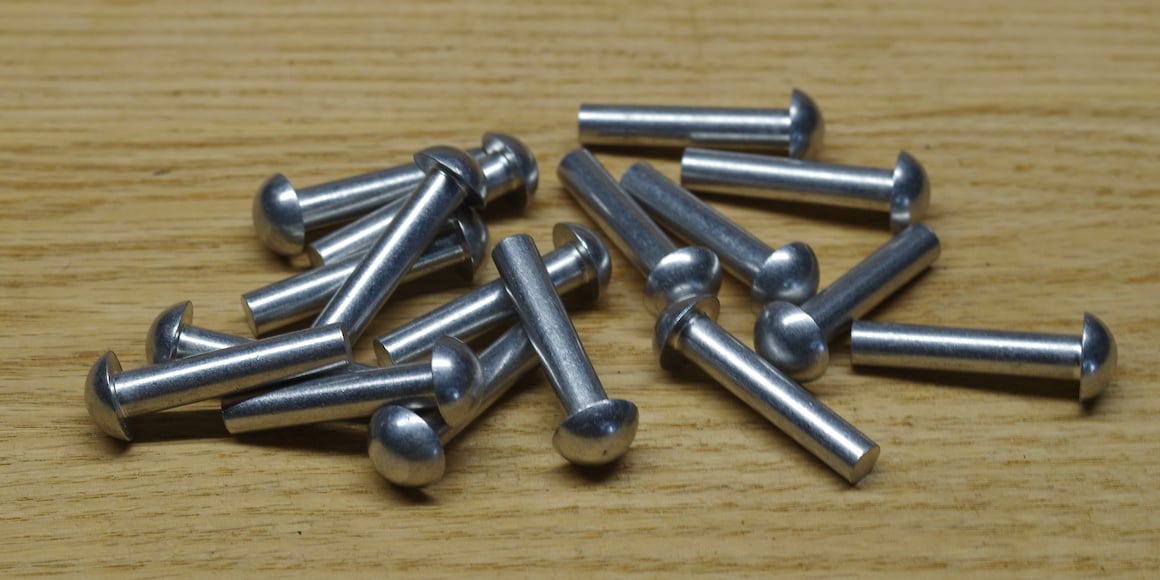
Solid rivets are perhaps the oldest known fastener. Rivets have been found in archaeological sites and are still used in construction, manufacturing, aerospace, automotive, boat building, and for hundreds of other applications. Rivets outperform screws, bolts, and even welds, but rivets must be properly installed to create a tight and lasting joint.
The basic principles of rivet installation haven’t changed over the ages. The ancient Egyptians used rivets to attach handles to clay pots and jars. Ancient Vikings and Romans used rivets in construction and to make everyday items. Today’s rivets evolved from the assembly of modern aircraft. (Remember Rosie the Riveter?) Today, solid rivets are used in everything from constructing buildings to making jeans.
Solid rivets are a common type of rivet. A solid rivet consists of a steel shank and a rounded or countersunk head. The rivet is installed by inserting it through a pre-drilled hole and then deforming or flattening the shank at the end opposite from the head to create a bond. Solid rivets are popular because they are relatively easy to install and remove without damaging the parent material, creating a lasting joint.
What makes solid rivets different from blind rivets is the need to have access to both sides of the workpiece. Blind rivets can be installed from one side of a joint; pulling the mandrel deforms the rivet on the blind side. With a solid rivet, you must have access to both sides of the rivet for a permanent installation.
Preferred Uses for Solid Rivets
Solid rivets are easy to install and inspect, so you can tell whether the installation has been done correctly. That’s why solid rivets are typically used in applications where reliability and safety matter.
Solid rivets are used in the construction of buildings and bridges. Solid rivets made of high-strength steel can be counted on to create a permanent joint that can withstand stress and vibration.
Solid rivets are also used in aircraft manufacturing. Rivets made of aluminum, titanium, and nickel alloy are ideal for connecting an airframe and an aircraft’s aluminum skin. Rivets are preferred over welds because they don’t compromise the parent material. Solid rivets can also be drilled out, so replacing damaged sections is easier.
Brass and copper rivets are used for boats, vats, and chemical tanks because they won’t corrode like steel rivets might. Solid rivets also ensure a strong joint for high-pressure applications, such as for manufacturing submarines or creating large tanks that hold tons of liquid.
Rivets can be used in almost any application that requires a strong, reliable joint. Solid rivets are permanent and can be removed without ruining the parent material. It’s all a matter of choosing the proper rivet for the task.
Installing Solid Rivets
One of the advantages of solid rivets is they don’t require special tools to install. All you need is a hammer and a bucking bar. To install a solid rivet, place the rivet in a pre-drilled hole, set the bucking bar against the back of the rivet, then strike the head with a hammer. The back of the rivet collapses against the bucking bar until it’s flush with the material and the joint is complete. Depending on the job, you may need two people to install the rivets: one to hammer and one to hold the bucking bar.
While you can install solid rivets by hand, pneumatic rivet tools make the job much easier. A solid rivet gun provides the impact force needed to secure the rivet.
The setting pressure for solid rivets is high, so you must choose a rivet gun with the right size and power for the job. You need a higher pressure for large rivets than you do for low rivets. The force of the rivet gun must be greater than the yield strength of the rivet.
For smaller rivets, the setting is around 345 pounds for a 3/32-inch diameter rivet and about 615 pounds for a 1/8-inch diameter rivet. You want a rivet gun that’s powerful enough to mushroom the blind side of the rivet. The force must also be properly aligned with the rivet so it doesn’t bend. If the rivet gun pressure is too high or too fast, it will mar the parent material.
You must also choose the right size rivet gun. The size is based on the size of the rivet hole. As a general rule, the diameter of the rivet should be from 2.5-3 times the width of the thickest sheet of material. The hole size should match the rivet diameter so you don’t have to force the rivet, which can affect the parent material.
The rivet length should be the total width of the workpiece plus 1.5 times the diameter of the rivet. The formula is:
Piece A + Piece B + (1.5X rivet diameter) = Rivet length
In other words, the tail of the rivet flattened by the bucking bar should be 1.5 times the width of the hole.
You must also match the rivet gun nose piece to the size and type of rivet head. Solid rivets use either a domed or flat head, depending on the finished look you want. Flat heads will be flush with the surface of the material once set. Using a nose piece that is too large for the rivet will mar the parent material.
Shop Solid Rivets on the Bay Supply Marketplace
When shopping for solid rivets, remember three critical attributes: rivets size, rivet material, and head type. If you match these three solid rivet characteristics to the job, the installation will be easier, and you can ensure a strong and lasting joint. The Bay Supply Marketplace has a complete line of solid rivets, so you can find a suitable fastener for any job. Contact us today for a quote.




Comments